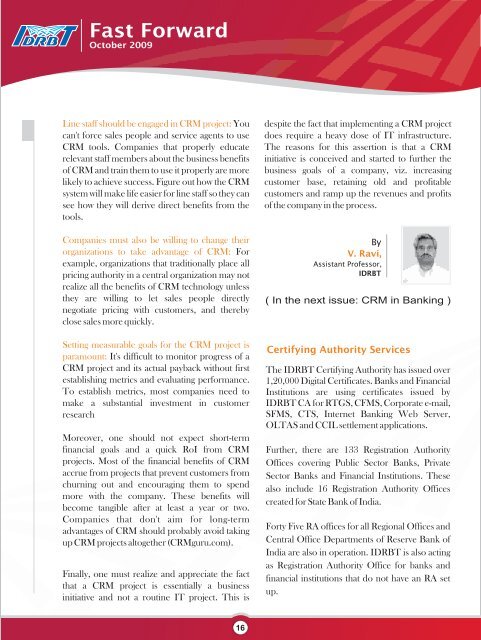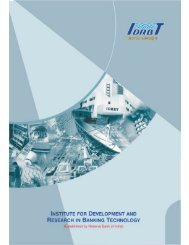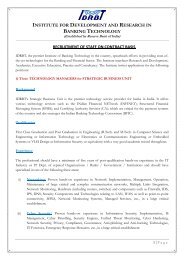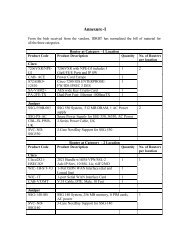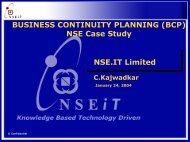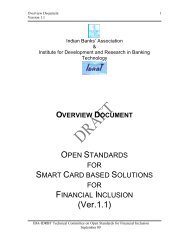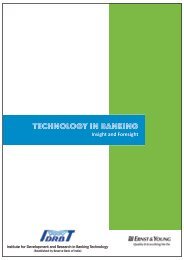Newsletter, October 2009 - IDRBT
Newsletter, October 2009 - IDRBT
Newsletter, October 2009 - IDRBT
Create successful ePaper yourself
Turn your PDF publications into a flip-book with our unique Google optimized e-Paper software.
Fast Forward<br />
<strong>October</strong> <strong>2009</strong><br />
Line staff should be engaged in CRM project: You<br />
can't force sales people and service agents to use<br />
CRM tools. Companies that properly educate<br />
relevant staff members about the business benefits<br />
of CRM and train them to use it properly are more<br />
likely to achieve success. Figure out how the CRM<br />
system will make life easier for line staff so they can<br />
see how they will derive direct benefits from the<br />
tools.<br />
Companies must also be willing to change their<br />
organizations to take advantage of CRM: For<br />
example, organizations that traditionally place all<br />
pricing authority in a central organization may not<br />
realize all the benefits of CRM technology unless<br />
they are willing to let sales people directly<br />
negotiate pricing with customers, and thereby<br />
close sales more quickly.<br />
Setting measurable goals for the CRM project is<br />
paramount: It's difficult to monitor progress of a<br />
CRM project and its actual payback without first<br />
establishing metrics and evaluating performance.<br />
To establish metrics, most companies need to<br />
make a substantial investment in customer<br />
research<br />
Moreover, one should not expect short-term<br />
financial goals and a quick RoI from CRM<br />
projects. Most of the financial benefits of CRM<br />
accrue from projects that prevent customers from<br />
churning out and encouraging them to spend<br />
more with the company. These benefits will<br />
become tangible after at least a year or two.<br />
Companies that don't aim for long-term<br />
advantages of CRM should probably avoid taking<br />
up CRM projects altogether (CRMguru.com).<br />
Finally, one must realize and appreciate the fact<br />
that a CRM project is essentially a business<br />
initiative and not a routine IT project. This is<br />
despite the fact that implementing a CRM project<br />
does require a heavy dose of IT infrastructure.<br />
The reasons for this assertion is that a CRM<br />
initiative is conceived and started to further the<br />
business goals of a company, viz. increasing<br />
customer base, retaining old and profitable<br />
customers and ramp up the revenues and profits<br />
of the company in the process.<br />
By<br />
V. Ravi,<br />
Assistant Professor,<br />
<strong>IDRBT</strong><br />
( In the next issue: CRM in Banking )<br />
Certifying Authority Services<br />
The <strong>IDRBT</strong> Certifying Authority has issued over<br />
1,20,000 Digital Certificates. Banks and Financial<br />
Institutions are using certificates issued by<br />
<strong>IDRBT</strong> CA for RTGS, CFMS, Corporate e-mail,<br />
SFMS, CTS, Internet Banking Web Server,<br />
OLTAS and CCIL settlement applications.<br />
Further, there are 133 Registration Authority<br />
Offices covering Public Sector Banks, Private<br />
Sector Banks and Financial Institutions. These<br />
also include 16 Registration Authority Offices<br />
created for State Bank of India.<br />
Forty Five RA offices for all Regional Offices and<br />
Central Office Departments of Reserve Bank of<br />
India are also in operation. <strong>IDRBT</strong> is also acting<br />
as Registration Authority Office for banks and<br />
financial institutions that do not have an RA set<br />
up.<br />
16


